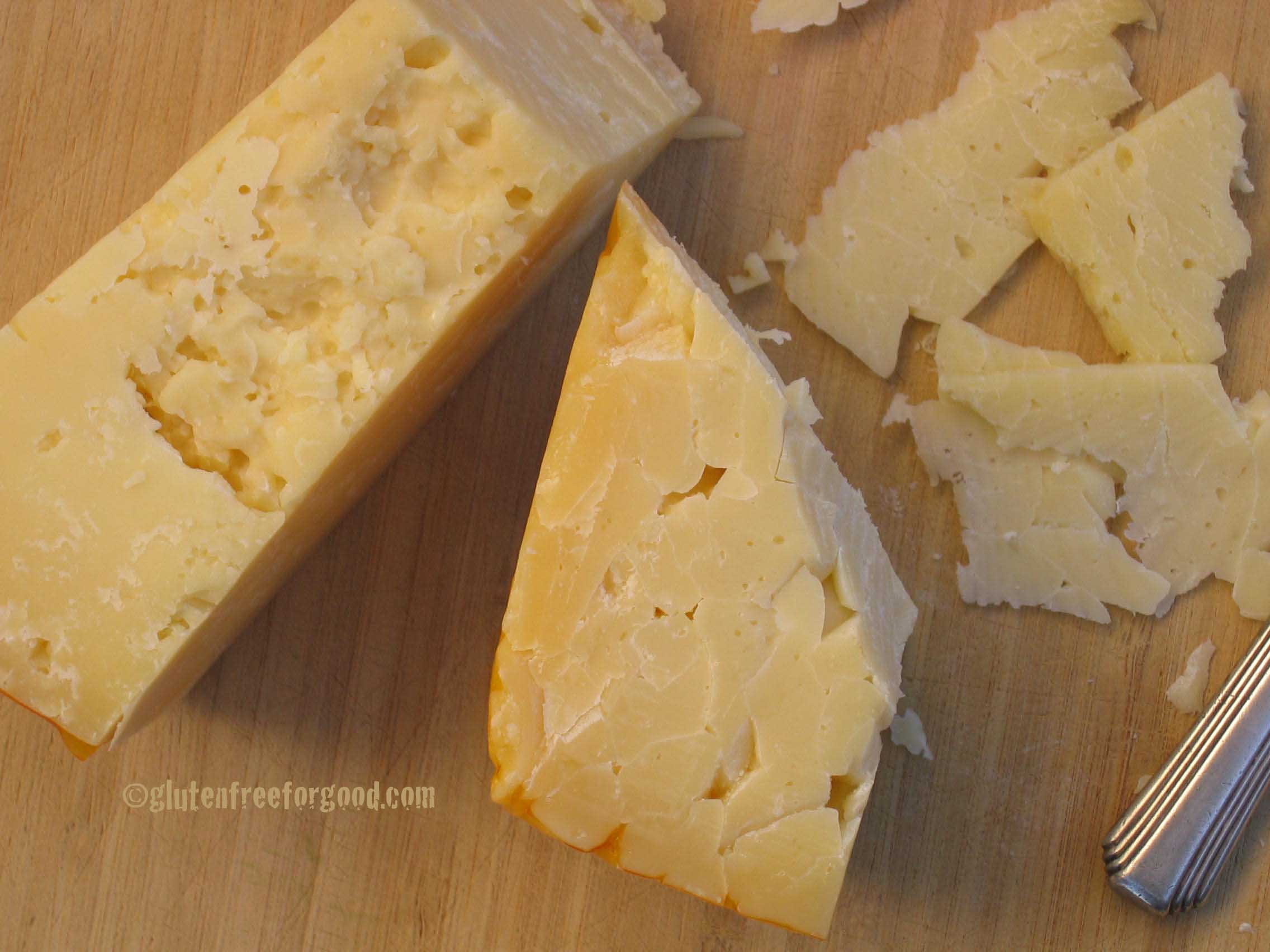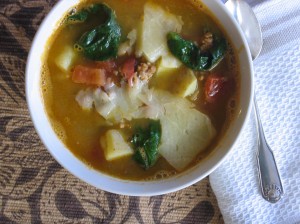People with celiac disease often have secondary issues with dairy products. That’s a long and convoluted story, but I’ve had some trouble with dairy in the past, so for the most part I avoid it. For information on milk and a basic glossary, check here for a past post I did on the subject.
Last Saturday I attended a membership gathering of the Raw Milk Association of Colorado and the local chapter of the Weston A. Price Foundation. Pete Kennedy, lawyer and VP for the Farm to Consumer Legal Defense Fund was the keynote speaker and did a presentation on raw milk trends and food politics. (I’m such a geek, I absolutely love this stuff.) David Lynch, founder and director of Guidestone, a non-profit dedicated to sustainable development and conserving regional agricultural resources, gave a historical perspective of how the raw milk movement has taken hold in Colorado and the legal aspects of buying and consuming it. David also owns Cottonwood Creek Dairy, which provides local folks in the Arkansas Valley of central Colorado an opportunity to share in the joys of raw milk from his Jersey milking herd. Dianne, a friend of mine from the holistic nutrition world did a short presentation on the benefits CLA (conjugated linoleic acid) in meat and milk from 100% grass fed animals. Not only were the speakers good, the local product exhibits were great as well. It was a day of nourishing food, good information, lively conversation, and food politics. I learned more about local grass-roots organizations that promote healthy living, sustainability, and ethical food production, which is something I’m very interested in.
Meg and Arden, owners of Windsor Dairy, sold me on trying some raw cheese from their certified organic dairy farm (I bought two types seen in the photo above). Both Meg and Arden are veterinarians and together have developed a system of dairy farming suited to Colorado’s altitude and growing conditions. They have cows derived from Brown Swiss and Tartentaise breeds from the Alps — perfect for our climate (not that I know anything at all about dairy cows). Arden gave me a quick info session on why some people with celiac disease and a casein intolerance might do okay on raw milk and cheese. He’s a vet and I don’t have a “regular” doctor, so I decided to take Arden’s advice and give it a try, starting with the most mouth watering cheese you’ve ever tasted. Here’s how I used their Nakhu cheese, which is a medium flavored raw cheese, reminiscent of traditional farmhouse English Cheddar. And that’s from a Swiss cow in the Colorado Rockies. A delightful taste of cultural diversity, wouldn’t you agree?
Spinach & potato soup with Nakhu cheese
what you need
1 large bunch of spinach, washed and coarsely chopped
1 medium onion, diced
4 or 5 cloves garlic, minced
4 medium-sized Yukon gold potatoes, washed and cut into 1/2 inch cubes (I don’t peel them)
1 can cannellini beans, drained
1 tomato, diced
1/2 pound chorizo sausage (make sure it’s gluten-free, ask the butcher)
6-8 cups chicken broth (I used Imagine Organic Free Range Chicken Broth, it’s GF)
olive oil
sea salt and fresh ground pepper to taste
cheese (in this case raw Nakhu cheese)
what you do
• Brown the sausage in a small amount of oil, drain and set aside.
• Using a heavy soup pot, heat a glug of olive oil and brown the onion over medium-low heat until soft.
• Add garlic to the onion mix and sauté for a few minutes, stirring often.
• Add the potatoes, some salt and pepper, stir and sauté for a few more minutes (3 to 5).
• Add the sausage and the chicken broth, bring soup almost to a boil, reduce heat and simmer for 45 minute or so.
• Add beans, spinach, and tomato about 10 minutes before serving.
• Salt and pepper as needed.
I added slices of the raw Nakhu cheese after I served it into the bowls. Let it melt a little bit and enjoy. If you don’t have access to raw cheese from a nearby dairy farm, grated parmesan would be nice.
Makes about 6 servings.
I’ll let you know how I do with my reintroduction of dairy products. Maybe sticking with raw, unpasteurized, organic cheeses and milk will be okay. Arden, my new vet, might be right. I’m keeping my fingers crossed.
Go forth and support your local farmers,
Melissa
Disclaimer: All material on this website is provided for informational and educational use only and should not be used for diagnostic purposes. Consult with your physician regarding any health or medical concerns you may have.
















Hi Melissa!
I’ve had your blog on my reader for quite a while now, but didn’t realize (how did I miss it???) that you are in Colorado! My parents live in Windsor and we were just there for Christmas. Just thought I’d say hi! Where do you live in Colorado?
Hey Staci,
Thanks for stopping by and leaving a comment. I love it when people “check in.” It’s so nice to connect with others who have similar interests. I live in Golden, not all that far from Windsor. Were your parents safe during the tornado? I belong to a CSA right up the road from Windsor and I bought this incredible raw cheese from the dairy right there in Windsor. It’s a beautiful area. Where are you?
I think that raw cheeses are a great choice for just about everyone! I think the flavor is worlds better, and I’m sold on the health bennies as well. I hope it helps out with your reintroduction of dairy!
Just bought a block of raw cheddar at our local co-op for use in a recipe later this week… just the smell of it is intoxicating!
I will be interested to see how you do with this new path, Melissa. I hope you do very well! I have had some issues with dairy myself, but do fine with goat’s milk products, including raw cheese. One of our support group couples has goats and regularly share yogurt, chevre, etc. Several of us have had dairy issues, but do well with these products and greatly enjoy them-they are so fresh and tasty. :-)Finally, that soup looks delicious!
Shirley
LO — you’re so right about the flavor being better. And yes, the health benefits as well. I’ll check back with you for your recipe using the raw cheddar.
🙂
Shirley — so far, so good. I get some subtle symptoms, but am thinking maybe organic, grass-fed, and raw milk products might be the answer. I’ll keep you posted. You’re new blog is awesome!
Melissa - Haven’t gotten around to the recipe quite yet, but I’m looking forward to it! Will be sure to share!
Absolutely delicious! So sorry you missed the Potato Ho Down deadline! It’s definitely Ho-worthy 😉
Christie — I’ll pay closer attention next time. Your run-down of spud dishes looked awesome.
This soup sounds amazing - I love chorizo! I hope your dairy experiment goes well. I avoided dairy altogether when I first went GF and introduced it back in a few months ago. I’m fine if I stick to small doses - and thank goodness because I don’t think I could live without cheese!
Hey Lauren — I know what you mean about the cheese thing! And honestly, this cheese from Windsor Dairy (pictured above) is over-the-top good. In fact, I think I’ll have a chunk now. Testing, testing.
🙂
Mom, this looks SO good! I really want to make it this week for lunch!
Much love,
t
Hey Tev — it IS good! If you didn’t live so darn far away you could have come over here for lunch.
🙂
Thanks so much, Melissa! I think we have a mutual fan club going on, because I always love coming here to find out what delicious and healthy news you have to share. 😉
MMMMM…
Casein is my problem. Leads to ezcema on my FACE! aRgh. Would love to eat cheese again, so, details please about why raw milk may be ok. I’m not sure you can get raw milk in NY. Maybe underground. I experimented with Buffalo yogurt/cheese and sheep, but funny thing- still got the ezcema, but on my arms instead of my face. Very strange. I want to know why the body reacts that way. What is going on inside to cause that.
Would you like one of my kefir baby grains? Can’t remember if I ever sent you one. No worries, you can make coconut milk kefir. I’d love it if you guest blogged about that. I’ve been meaning to write about it, but I love how you can write more authoritative about foods as a nutritionist. Just an idea.
Kelly,
Yes, this is interesting and I’m doing lots of research, learning some interesting things, and doing some testing on myself. I’d be happy to do a guest blog as I think this is an important subject for people in general, but especially for those of us with celiac because of all the secondary food issues that often tag along with this “disease.” Fascinating stuff, actually.
I’ve just never been on the mainstream medical bandwagon with this, but am grateful for their wisdom in certain areas and think the best way to approach celiac is through integrative channels. I’m on a roll with my own health and really want to help others thrive, not just get by. Food, it’s about FOOD. But we must choose healing and nourishing food. Aren’t we lucky?! Seriously, I feel blessed (well, except for the money thing).
We need to talk.
🙂
Melissa
Yes, let’s talk.
And that is how I’ve always felt about it too…we all know that whole foods are the way we should be eating, but this disease just forced me to eat that way…and now I’m grateful for the discipline it has taught me.
Kelly,
I’m working on an “alternative” and holistic presentation regarding healing and thriving with celiac. I’m not all that interested in gluten free packaged foods. There’s so much more to healing and maintaining a strong body and vibrant health. Lots of aspects to it.
By the way, your bread recipe looks amazing. I’m definitely going to give that one a try. I love it that you used blackstrap molasses!
http://www.celiacchicks.com/2009/01/glutenfree-recipes-glutenfree-bread.html
Hi Melissa,
I go to a holistic practitioner for food allergy tests. On my last visit, regular cow’s milk cheeses
showed I would reacto to them. My raw milk cheese from the Amish farmers at the farmer’s market tested okay. So without doing any research (again!) I arrived at the same conclusion as you. And those market cheeses taste fabulous!
The guy who makes the goat cheese told me he could not make mozzarella out of goat milk. So I’ve been making pizza with creamy goat cheese and raw milk colby. It works for me!